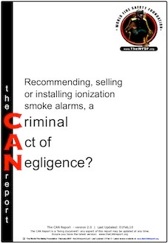



The CAN Report
The CAN Report was sent by registered mail to eighty eight recipients in Australia, New Zealand, Canada and the USA, The report warned of flawed smoke alarm research, dating back to 1976, which has been relied upon by fire authorities in the formulation of smoke alarm standards around the world.
In April 2004, the Australian Building Codes Board (ABCB) adopted the amendment to Australia’s Smoke Alarm Standard AS1670.1, which now mandates photoelectric smoke detectors in all sleeping areas and exit paths in all new Australian commercial buildings to which this standard applies. However, despite overwhelming evidence that ionization smoke alarms are not fit-for-purpose, the ABCB still refuses, without just cause, to adopt the corrected Australian Smoke Alarm Standard into the Building Code of Australia.
If the ABCB adopts the corrected standard it will allow Australian homes the same safe level of protection (i.e. with photoelectric technology) afforded to Australian commercial buildings and set global precedence that existing standards testing of ionization smoke alarms is flawed.
-
- - - - - - - - - - More Evidence - - - - - - - - - -
- See: ‘Fire Protection Association Australia - Smoke Alarm Fact Sheet’
- See: ‘Closing the Deadly Loophole in Australia’s Flawed Smoke Alarm Standard’
- See: ‘Hagens Berman Sobol Shapiro LLP -- Class Action Complaint And Jury Demand’
- See: ‘Hackert v BRK Brands, Inc. & First Alert, Inc. -- Summary Order’
- See: ‘Hide A Crime - Commit A Crime’

‘Recommending Selling or Installing Ionization Smoke Alarms, a Criminal Act of Negligence?’
Warning about Australia’s flawed
smoke alarm standard (AS3786)
Download: Here > > >

Published: 19 Feb, 2007 Updated: 01 Feb, 2010
The CAN Report

“What we discovered to our horror, as the Australian Standards Committee doing some
enquiries into test data, was that the ionization smoke alarms are allowed to go to
50-60% [smoke] obscuration per metre, dangerously high, totally unacceptable.”
Ionization Smoke Alarms - “Totally Unacceptable!”

Mr David Isaac, Member Standards Australia Committee FP002 (page 8)


“This is information that no one in this..
fire station had until a few days ago.”

Captain Russell Ashe, Barre City F.D., Vermont, USA, June 2006, page 6
Stated by Captain Russell Ashe in June 2006, in Barre City
Vermont, after four children and their mother died in a home
fitted with hard-wired, working, ionization smoke alarms.



Scientific Misconduct?
NIST’s credibility under fire
More about NIST is
Here > > >
NIST’S ‘Performance of Home Smoke Alarms Report’
“NIST’s reports are relied upon by
Fire Brigades, safety organisations
and regulatory authorities globally.
The conclusions of the NIST Report
are contradicted by their own data.”
‘The CAN Report’, Summary page 2
Scroll for all 17 pages




Deadly Loophole Discovered in Australia’s Smoke Alarm Standard


(c) Copyright 2011 The World Fire Safety Foundation | Last Updated: 06 March, 2012 | Privacy Policy | Disclaimer | Search WFSF site
For errors on, or suggestions for this ‘can’ webpage, contact the WFSF WebMaster | Supporters | About | Media